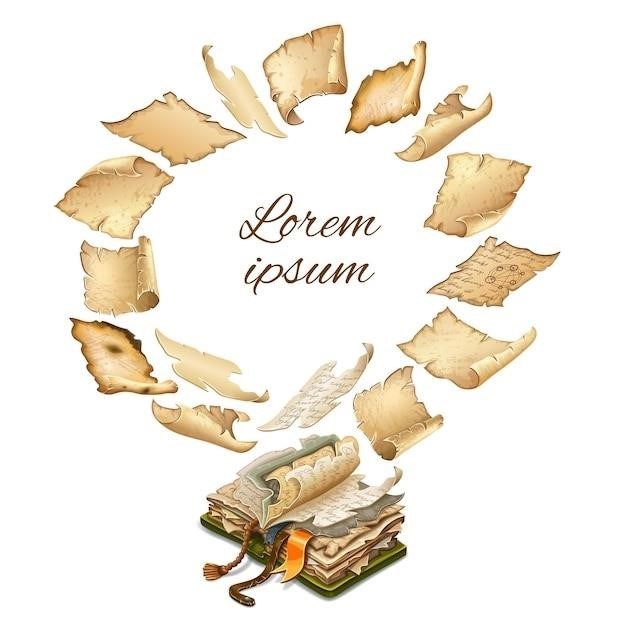The Secret Book of John⁚ An Overview
The Secret Book of John‚ also known as the Apocryphon of John‚ is a significant 2nd-century Gnostic text. Discovered in the Nag Hammadi Library‚ it offers a unique perspective on early Christianity and Gnostic beliefs‚ detailing Jesus’s secret teachings to John.
What is the Secret Book of John?
The Secret Book of John‚ also called the Apocryphon of John or the Secret Revelation of John‚ is a second-century Gnostic text. It’s considered a pseudepigraphical work‚ attributed to the Apostle John but likely written by an unknown author within the Sethian Gnostic tradition. This influential text‚ part of the Nag Hammadi Library’s discovery‚ presents a unique cosmology and narrative‚ diverging significantly from canonical Christian scripture. It details Jesus’s revelations to John‚ encompassing esoteric knowledge and a distinct creation myth. The book’s significance lies in its contribution to understanding early Gnostic beliefs and their relationship with mainstream Christianity during that era. Its complex mythology and symbolism have fascinated scholars and spiritual seekers alike for decades‚ prompting ongoing study and interpretation.
Its Gnostic Origins and Significance
The Secret Book of John firmly resides within the Gnostic tradition‚ showcasing core Gnostic tenets. Its Sethian origins are evident in its unique cosmology and emphasis on secret knowledge (“gnosis”) leading to salvation. Unlike orthodox Christianity‚ which emphasizes faith and grace‚ Gnosticism‚ as reflected in this text‚ highlights the importance of acquiring esoteric understanding to escape the material world’s limitations and achieve spiritual liberation. The text’s narrative structure‚ featuring Jesus’s revelations to John‚ exemplifies the Gnostic belief in a divine spark within humanity‚ capable of recognizing and accessing higher truths. The Secret Book of John’s significance lies in its detailed exposition of Gnostic beliefs‚ offering invaluable insight into this complex religious movement’s inner workings and theological framework. Its discovery significantly advanced scholarly understanding of Gnosticism’s diversity and influence.
Historical Context and Discovery
Unearthed in 1945 within the Nag Hammadi Library in Egypt‚ the Secret Book of John offers a glimpse into early Christian Gnosticism. Its dating remains debated‚ placing it likely before 180 AD.
Dating and Authorship
Pinpointing the precise date and author of the Secret Book of John remains a scholarly challenge. Scholars generally agree that the text originated sometime during the early 2nd century CE‚ a period of significant religious ferment and evolving Christian thought; Irenaeus’s mention of the text in his “Against Heresies‚” written before 180 CE‚ provides an upper bound for its composition. The anonymous nature of the authorship adds to the mystery surrounding the text’s origins. Its Sethian Gnostic leanings suggest connections to specific schools of thought within early Gnosticism. However‚ the lack of explicit authorial claims leaves the identity of the scribe or the intellectual lineage of the text open to scholarly interpretation and debate. Further research and analysis of the manuscript’s textual features might one day shed more light on these questions. The continued study of related Gnostic texts and a deeper understanding of the socio-religious context of the 2nd century may help illuminate the authorship puzzle.
The Nag Hammadi Library and its Importance
The discovery of the Nag Hammadi Library in 1945 in Upper Egypt proved to be a watershed moment in the study of early Christianity and Gnosticism. This collection of thirteen codices‚ containing numerous Gnostic texts‚ offered an unparalleled glimpse into the diverse religious landscape of the late antique world. Among these invaluable texts was the Secret Book of John‚ a key example of Sethian Gnosticism. The Nag Hammadi Library’s significance lies not only in its sheer volume of previously unknown material but also in its representation of various Gnostic schools of thought. The texts‚ written in Coptic‚ provide invaluable primary sources for understanding the beliefs‚ practices‚ and internal debates within early Gnostic communities. The discovery challenged traditional views of early Christianity‚ highlighting the rich diversity of thought and the complexity of interactions between emerging Christian and Gnostic ideas. The Nag Hammadi Library’s contents continue to shape scholarly understanding of Gnosticism and its relationship to early Christianity.

Key Themes and Interpretations
The Secret Book of John explores the fall of God‚ secret knowledge‚ and Gnostic cosmology. It presents a unique creation myth and emphasizes the importance of gnosis for spiritual liberation.
The Fall of God and the Creation Myth
The Secret Book of John presents a distinctive Gnostic creation myth‚ diverging sharply from traditional biblical accounts. Instead of a benevolent creator God‚ this text portrays a flawed‚ even fallen‚ deity. The narrative depicts God’s descent from a state of perfect Oneness‚ a primordial unity‚ into a condition of limitation and imperfection within the material world. This “fall” is not a moral lapse but a cosmological event‚ a necessary stage in the unfolding of existence. The creation itself is presented not as a divine act of benevolence but as a consequence of this fall‚ a manifestation of God’s limitations. The material world‚ therefore‚ is not inherently evil but rather a realm of imperfection‚ a consequence of God’s own limitations and the inherent duality within the divine nature. This perspective profoundly shapes the Gnostic understanding of salvation and the path to spiritual liberation.
Secret Knowledge and Gnostic Beliefs
Central to the Secret Book of John is the concept of “gnosis‚” meaning secret knowledge or enlightenment. This knowledge‚ unavailable to ordinary individuals‚ is revealed by Jesus to John‚ highlighting the text’s Gnostic nature. Gnosticism emphasizes a dualistic worldview‚ distinguishing between the spiritual realm and the material world‚ viewing the latter as imperfect or even evil. The secret knowledge in the text illuminates the true nature of reality‚ the divine spark within each individual‚ and the path to liberation from the material world’s constraints. This liberation involves recognizing one’s divine nature and escaping the cycle of reincarnation. The text emphasizes a direct‚ experiential understanding of the divine‚ contrasting with the reliance on established religious institutions and doctrines. This pursuit of personal spiritual enlightenment defines the core of Gnostic beliefs as presented in the Secret Book of John.
The Book’s Content and Structure
The Secret Book of John presents a narrative structure‚ unfolding through dialogues and visions. Key passages detail Jesus’s revelations to John‚ exploring Gnostic cosmology and salvation.
Narrative Structure and Key Passages
The Secret Book of John unfolds as a series of dramatic encounters and revelations‚ primarily structured around dialogues between John and Jesus. These conversations unveil profound Gnostic teachings‚ including the nature of the divine‚ the creation of the world‚ and the path to spiritual liberation. Key passages describe the fall of God‚ the origin of evil‚ and the pivotal role of secret knowledge (gnosis) in achieving salvation. Jesus’s instructions to John often involve symbolic interpretations and allegorical narratives. The text’s narrative arc traces John’s spiritual journey‚ culminating in his understanding of the hidden truths revealed by the ascended Christ. These revelations are not presented as straightforward historical accounts but rather as mystical insights into the divine realm and humanity’s place within it. The structure skillfully interweaves narrative elements with philosophical discussions‚ creating a richly layered and symbolic text. The overall effect is a dramatic unveiling of esoteric wisdom‚ emphasizing the transformative power of gnostic understanding. The narrative’s intensity is heightened by the contrasting perspectives of John’s earthly experiences and the transcendent visions he receives from Jesus.
Symbolism and Allegory
The Secret Book of John is replete with symbolism and allegory‚ reflecting the Gnostic tradition’s emphasis on hidden meanings and mystical interpretations. The text utilizes symbolic figures and narratives to convey complex theological concepts. For instance‚ the “fall of God” isn’t a literal event but an allegorical representation of the divine’s self-limitation or descent into the material world. Similarly‚ the various celestial beings and realms described are not necessarily to be taken literally‚ but as symbolic representations of spiritual realities. The use of light and darkness‚ often associated with knowledge and ignorance respectively‚ is a recurring motif. Specific numbers and names may also hold symbolic significance within the text’s Gnostic framework. Understanding the symbolism requires a careful reading and an awareness of the Gnostic worldview‚ which interprets reality through a lens of hidden spiritual truths. The allegorical nature of the text encourages multiple layers of interpretation‚ leading to a rich and multifaceted understanding of its underlying message. This rich tapestry of symbolic language enhances the text’s mystical and esoteric character‚ reinforcing its Gnostic identity.

Modern Scholarship and Reception
Scholarly interest in the Secret Book of John remains high‚ fueling ongoing debates about its origins‚ meaning‚ and influence on Gnostic thought and early Christianity. Its accessibility through online PDFs aids modern study.
Scholarly Interpretations and Debates
The Secret Book of John‚ readily available in PDF format online‚ has sparked considerable scholarly debate. Interpretations vary widely‚ reflecting diverse perspectives on Gnosticism and its relationship to early Christianity. Some scholars emphasize the text’s cosmological mythology‚ focusing on its depiction of the divine realm and the creation of the world. Others highlight its soteriological aspects‚ exploring its ideas about salvation and liberation from the material world. The text’s literary style and structure are also points of contention‚ with some arguing for a unified composition‚ while others suggest multiple layers of authorship or redaction. The influence of other religious and philosophical traditions on the Secret Book of John is another area of ongoing discussion. Reconciling its purportedly Gnostic elements with its apparent Christian themes remains a challenge. The availability of the text in digital form has undeniably facilitated this ongoing scholarly discourse.
The Book’s Influence on Gnostic Studies
The Secret Book of John‚ easily accessible in numerous PDF versions online‚ holds a pivotal position within Gnostic studies. Its discovery within the Nag Hammadi Library revolutionized scholarly understanding of Gnosticism‚ providing a rich and detailed example of Sethian Gnostic thought. The text’s complex cosmology‚ unique mythology‚ and depiction of Jesus’s secret teachings have profoundly impacted interpretations of other Gnostic texts. Scholars frequently cite the Secret Book of John when discussing Gnostic concepts of creation‚ salvation‚ and the nature of divinity. The readily available PDF versions have broadened access to the text‚ stimulating further research and analysis. Its influence extends beyond academic circles; the book has become a significant resource for those interested in exploring alternative spiritualities and the history of early Christianity. The ongoing availability of the Secret Book of John in PDF format ensures its continued relevance in Gnostic scholarship.
